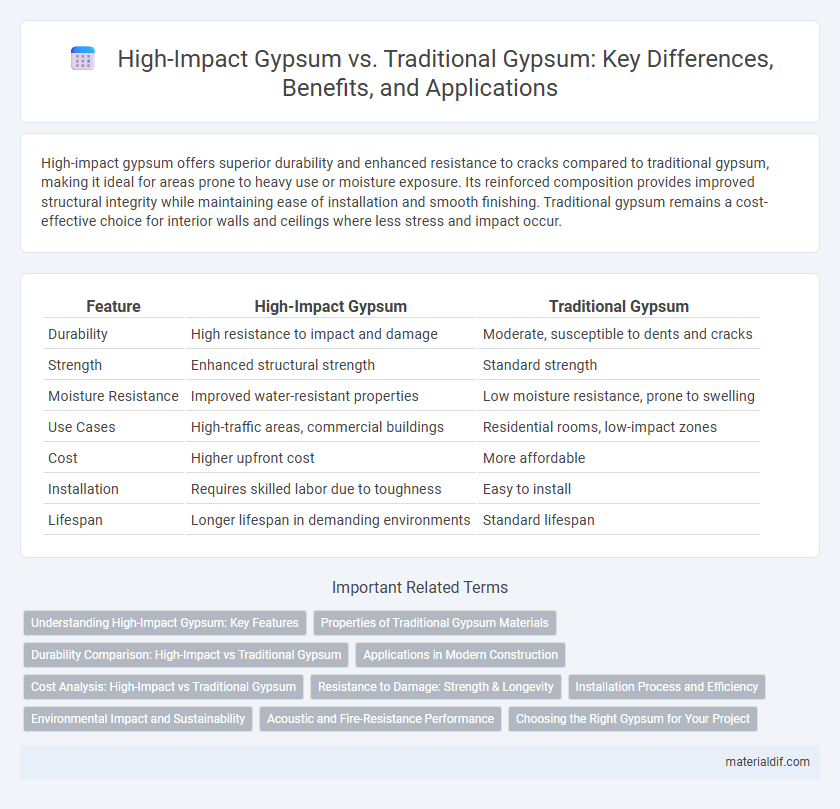High-impact gypsum offers superior durability and enhanced resistance to cracks compared to traditional gypsum, making it ideal for areas prone to heavy use or moisture exposure. Its reinforced composition provides improved structural integrity while maintaining ease of installation and smooth finishing. Traditional gypsum remains a cost-effective choice for interior walls and ceilings where less stress and impact occur.
Table of Comparison
| Feature | High-Impact Gypsum | Traditional Gypsum |
|---|---|---|
| Durability | High resistance to impact and damage | Moderate, susceptible to dents and cracks |
| Strength | Enhanced structural strength | Standard strength |
| Moisture Resistance | Improved water-resistant properties | Low moisture resistance, prone to swelling |
| Use Cases | High-traffic areas, commercial buildings | Residential rooms, low-impact zones |
| Cost | Higher upfront cost | More affordable |
| Installation | Requires skilled labor due to toughness | Easy to install |
| Lifespan | Longer lifespan in demanding environments | Standard lifespan |
Understanding High-Impact Gypsum: Key Features
High-impact gypsum offers superior strength and durability compared to traditional gypsum, making it ideal for high-traffic areas and structural applications. This advanced gypsum variant incorporates enhanced additives and reinforced fibers that significantly improve resistance to impact, moisture, and cracking. Its engineered composition results in longer-lasting walls and ceilings while maintaining easy installation and environmental sustainability.
Properties of Traditional Gypsum Materials
Traditional gypsum materials are characterized by their moderate compressive strength, good fire resistance, and excellent workability, making them widely used in interior wall and ceiling applications. They typically have a density ranging from 600 to 900 kg/m3 and a setting time that allows for easy molding and shaping during installation. Compared to high-impact gypsum, traditional gypsum offers less impact resistance but provides sufficient durability for standard residential and commercial construction projects.
Durability Comparison: High-Impact vs Traditional Gypsum
High-impact gypsum exhibits superior durability compared to traditional gypsum due to its enhanced resistance to cracks, moisture, and impact damage. Engineered with reinforced fibers and additives, high-impact gypsum maintains its structural integrity in high-traffic areas and humid environments where traditional gypsum often deteriorates. This improved durability significantly extends the lifespan of walls and ceilings, reducing maintenance and replacement costs.
Applications in Modern Construction
High-impact gypsum offers enhanced strength and durability compared to traditional gypsum, making it ideal for high-traffic areas and load-bearing walls in modern construction. Its improved resistance to moisture and impact enables use in commercial buildings, sports facilities, and healthcare environments, where standard gypsum may fail prematurely. The material's superior performance reduces maintenance costs and extends the lifespan of interior partitions and ceilings in demanding architectural applications.
Cost Analysis: High-Impact vs Traditional Gypsum
High-impact gypsum offers enhanced durability and improved resistance to cracks, justifying a higher initial investment compared to traditional gypsum. Cost analysis reveals that while traditional gypsum has lower upfront expenses, its frequent repairs and replacements can lead to increased long-term costs. Evaluating total lifecycle costs, high-impact gypsum provides better value through reduced maintenance and extended service life.
Resistance to Damage: Strength & Longevity
High-impact gypsum exhibits superior resistance to damage compared to traditional gypsum, thanks to its enhanced density and added reinforcement fibers that improve tensile strength. This advanced formulation increases durability, reducing susceptibility to cracks, dents, and moisture-related deterioration over time. As a result, high-impact gypsum offers prolonged structural integrity and lower maintenance costs in demanding construction environments.
Installation Process and Efficiency
High-impact gypsum boards offer a streamlined installation process due to their enhanced durability and reduced need for frequent handling precautions, resulting in faster project completion times compared to traditional gypsum. These boards require fewer fasteners and less joint treatment, significantly improving labor efficiency and minimizing material waste on-site. The superior strength also reduces repair and replacement needs during installation, optimizing overall workflow and cost-effectiveness.
Environmental Impact and Sustainability
High-impact gypsum significantly reduces environmental impact by utilizing industrial by-products like flue-gas desulfurization (FGD) gypsum, which diverts waste from landfills and lowers CO2 emissions compared to traditional gypsum mining. Sustainability is enhanced through decreased resource extraction and energy consumption in production, promoting circular economy principles. Traditional gypsum extraction often leads to habitat disruption and higher carbon footprints, whereas high-impact gypsum supports greener construction practices and eco-friendly material life cycles.
Acoustic and Fire-Resistance Performance
High-impact gypsum offers superior acoustic insulation with enhanced sound dampening properties compared to traditional gypsum, making it ideal for noise-sensitive environments. Its advanced fire-resistant composition significantly delays heat transfer and smoke development, providing greater safety in building applications. These performance improvements make high-impact gypsum a preferred choice for meeting stringent building codes and enhancing overall structural resilience.
Choosing the Right Gypsum for Your Project
High-impact gypsum offers superior strength and durability compared to traditional gypsum, making it ideal for projects requiring enhanced resistance to impact and moisture. Traditional gypsum remains a cost-effective solution suitable for standard interior walls and ceilings with minimal exposure to stress. Selecting the right gypsum depends on project demands, budget constraints, and environmental conditions to ensure optimal performance and longevity.
High-impact gypsum vs Traditional gypsum Infographic

 materialdif.com
materialdif.com